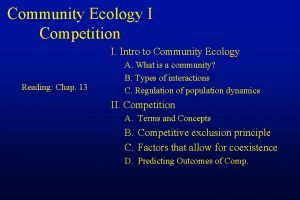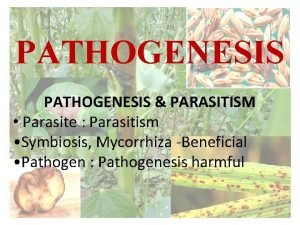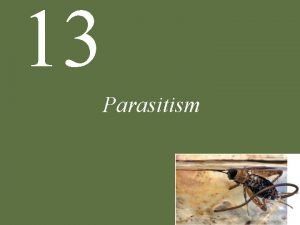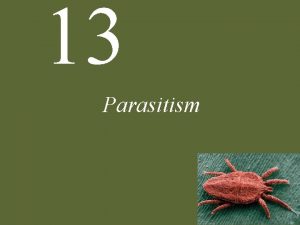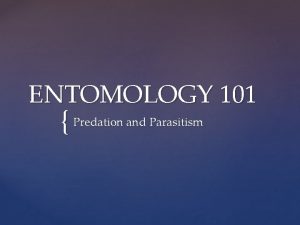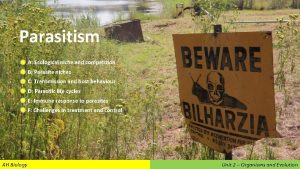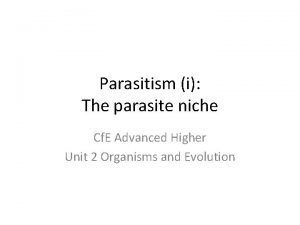Parasitism 1 Niche The niche for an organism

































- Slides: 33

Parasitism 1

Niche The niche for an organism is often defined as the role an organism plays in its environment The environmental niche encompasses the requirements of the species along with its tolerances to the environment in which it exists. The environmental niche is multidimensional as organisms interact with the biotic and abiotic factors in their environment 2

Niche A species has a fundamental niche. This is the niche it occupies if there is no interspecific competition influencing it. A species is more likely to occupy its realised niche. This is the reality when interspecific competition influences organisms 3

Niche Interspecific competition can result in competitive exclusion if the niches of two species are so similar that one species declines locally to extinction If realised niches are different enough between competitors they can co-exist by resource partitioning 4

The parasite niche A parasite is a symbiont gaining benefit at the expense of its host (usually nutrients) 5

The parasite niche The reproductive potential of the parasite is greater than the host Parasitic wasp larvae 6

The parasite niche Parasites tend to have a narrow niche as they are very host specific. The host provides many of the parasite’s needs. Parasites often lack structures and organs (or they are degenerate) found in other organisms as they are no longer needed. 7

The parasite niche Ectoparasites live on the surface of its host. Endoparasites live within the host 8

The parasite niche The organism on or in which the parasite reaches sexual maturity is the definitive host Intermediate hosts may also be needed for the parasite to complete its life cycle A vector plays an active role in the transmission of the parasite and may also be a host 9

Parasite transmission and virulence Transmission is the spread of a parasite to a host Virulence is the harm caused to a host species by a parasite 10

Parasite transmission and virulence Factors that increase transmission rates are: Overcrowding of hosts in high density populations Spreading mechanisms used by the parasite even when the host is incapacitated including vectors and water borne dispersal 11

Parasite transmission and virulence Host behaviour can be exploited and modified by parasites to maximise transmission This can include changes in host foraging, movement, sexual behaviour, habitat choice and anti-predator behaviour These modified behaviours essential become an extended part of the parasites phenotype 12

Parasite transmission and virulence Parasites often suppress the host immune system and modify host size and reproductive rate in such a way that the parasites growth, reproduction and transmission may be benefitted Parasite distribution will not be uniform across hosts in a population Sexual and asexual phases in parasite life cycles allow rapid evolution and rapid build-up of parasite populations 13

Immune response to parasites Epidemiology is the study of the outbreak and spread of infectious disease. Herd immunity is the protection given indirectly to the non-immune minority by the immune majority. The herd immunity threshold is the density of resistant hosts in the population required to prevent an epidemic. (Depends on pathogen virulence, vaccine efficacy and population contact parameters) 14

Non specific defences of mammals Physical barriers (epithelial cells) Chemical secretions (sweat, sebum, tears, enzymes, saliva, mucus, acid) Inflammatory response (histamine, cytokines) Phagocytes Natural killer cells destroying abnormal cells (virus infected cells triggered to self destruct by signal molecule) 15

Specific cellular defence in mammals Immune surveillance by white blood cells Damage or invasion stimulates cytokine production Phagocytes and T cells are produced and attracted to the site Clonal selection of T lymphocytes An antigen will be recognised by a T lymphocyte The T lymphocyte will divide repeatedly to form a clonal population 16

Specific cellular defence in mammals T lymphocytes targeting immune response and destroying infected cells by inducing apoptosis Helper T cells (TH cells) secrete cytokines activating phagocytes, TC cells and B cells) Cytotoxic T cells (TC cells) destroy infected cells including by apoptosis Phagocytes presenting antigens to lymphocytes Phagocytes will present pathogen’s antigens on its surface Helper T cells activated to produce activated TH cells or memory TH cells 17

Specific cellular defence in mammals The clonal selection of B lymphocytes Specific B cells stimulated by cytokines from activated TH cells Many B cells made as clones Some activated to make specific antibody others Long term survival of some members of T and B lymphocytes clones to act as immunological memory cells 18

Immune response to parasites Endoparasites mimic host antigens to evade detection by the immune system Endoparasites modify host immune response to reduce their chances of destruction Antigenic variation in some parasites allows them to evolve faster than the host immune system can respond to the new antigen 19

Parasitic life cycles Common parasites include: Protists Platyhelminths Nematodes, Arthropods Bacteria Viruses 20

Parasitic life cycles - protists 21

Parasitic life cycles - platyhelminthes 22

Parasitic life cycles - nematodes 23

Parasitic life cycles - arthropods 24

Parasitic life cycles - bacteria 25

Parasitic life cycles - viruses 26

Parasitic life cycles Many parasites require more than one host to complete their life cycle Plasmodium spp. which cause malaria in humans Schistosoma spp. (platyhelminth) which cause schistosomiasis (bilharzia) in humans 27

Parasitic life cycles Ectoparasites and endoparasites of the main body cavities, such as the gut, are generally transmitted through direct contact or by consumption in secondary host Endoparasites of the body tissues are often transmitted by vectors 28

Parasitic life cycles Parasites can complete their life cycle within one host such as some endoparasitic amoeba and ectoparasitic arthropods, bacteria and viruses. Human diseases include tuberculosis, caused by bacteria and influenza and HIV caused by viruses 29

Parasitic life cycles - viruses Viruses are infectious agents that can only replicate inside a host cell. Viruses contain genetic material in the form of DNA or RNA, packaged in a protective protein coat. The outer surface of a virus contains antigens that a host cell may or may not be able to detect as foreign. RNA retroviruses use the enzyme reverse transcriptase to form DNA, which is then inserted into the genome of the host cell. This virus gene forms new viral particles when transcribed. 30

Challenges in treatment and control Some parasites are difficult to culture in the laboratory. Rapid antigen change has to be reflected in the design of vaccines The similarity between host and parasite metabolism makes it difficult to find drug compounds that only target the parasite 31

Challenges in treatment and control Civil engineering projects to improve sanitation combined with coordinated vector control may often be the only practical control strategies 32

Challenges in treatment and control Challenges arise where parasites spread most rapidly as a result of overcrowding or tropical climates. Improvements in parasite control reduces child mortality and results in population-wide improvements in child development and intelligence as individuals have more resources for growth and development 33
 Why does organism eat another organism
Why does organism eat another organism Whats an organism's niche
Whats an organism's niche Can a realized niche be larger than a fundamental niche
Can a realized niche be larger than a fundamental niche Mullerian vs batesian mimicry
Mullerian vs batesian mimicry Datumr
Datumr Karttecken höjdkurva
Karttecken höjdkurva Rbk fuktmätning
Rbk fuktmätning Matematisk modellering eksempel
Matematisk modellering eksempel Datorkunskap för nybörjare
Datorkunskap för nybörjare Cks
Cks Verktyg för automatisering av utbetalningar
Verktyg för automatisering av utbetalningar Returpilarna
Returpilarna Kyssande vind analys
Kyssande vind analys Bris för vuxna
Bris för vuxna Stig kerman
Stig kerman Strategi för svensk viltförvaltning
Strategi för svensk viltförvaltning Frgar
Frgar Formel gruplar
Formel gruplar Vad är verksamhetsanalys
Vad är verksamhetsanalys Tack för att ni har lyssnat
Tack för att ni har lyssnat Klassificeringsstruktur för kommunala verksamheter
Klassificeringsstruktur för kommunala verksamheter Vilotidsbok
Vilotidsbok Påbyggnader för flakfordon
Påbyggnader för flakfordon Tack för att ni lyssnade
Tack för att ni lyssnade Kontinuitetshantering i praktiken
Kontinuitetshantering i praktiken Egg för emanuel
Egg för emanuel Lek med geometriska former
Lek med geometriska former Etik och ledarskap etisk kod för chefer
Etik och ledarskap etisk kod för chefer Atmosfr
Atmosfr Rutin för avvikelsehantering
Rutin för avvikelsehantering Shingelfrisyren
Shingelfrisyren Presentera för publik crossboss
Presentera för publik crossboss Bamse för de yngsta
Bamse för de yngsta Debatt mall
Debatt mall


